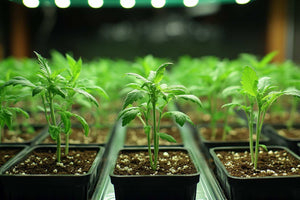
With the legalisation of marijuana, users and businesses began to grow marijuana by themselves, and it's been an incredible journey! However, as with any new venture, there have been some challenges along the way. One of the most exciting developments in the marijuana industry is the advent of LED grow lights.
Cannabis needs a lot of light to produce high-quality plants and flowers. On average, a cannabis plant takes twelve hours of darkness to flower each day. The more light your plants get, the better and stronger they grow, which leads to higher yields – so let there be light!
The use of grow lamps
While it's great for outdoor cultivation, some growers prefer to use lighting because it allows them to better control the plant and the growing season. Just pointing the bulb at your plant isn't enough for it to grow properly. To replace the sun with lighting, you need to use lamps that are specially made for growing cannabis.
How a cannabis plant grows depends on the way the grow lamps are used. When it comes to choosing the right lamp for your cannabis plants, there are a few great options to consider. Metal halide lamps, high-pressure sodium vapor lamps and special LED grow lamps are all excellent choices.
Fluorescent lamps are also worth a try because they give off the best blue light for leaf growth. The MH lamps work best during the vegetative phase, while the ND lamps produce the best light during the flowering phase.
Distance between the grow lamps
The distance between the lamps is crucial for the growth of your plants. It's the perfect opportunity to get creative! If they are too far away, your cannabis will not get the light it needs, but if they are too close, you risk burning your valuable plants. It's a challenge that's worth taking on!
During the nursery stage of the plant, it is essential to keep the lights at the correct distance. One of the biggest mistakes made by growers is to keep the lights too far away. This is your chance to learn and grow!
This results in plants that are long and slender, with weak stems that cannot support the weight of the plant and can hang upside down. These elongated stems appear when the seedlings are stretched to get more light, which is a fascinating process!
The actual optimal distance of your lamps depends on the type of light used and your grow room. Here are some basic guidelines:

Light intensity
It's a fact that plants that get more light tend to grow better and get higher yields. But it's also easy to over-saturate your plants with light and cause them to burn easily. Or adjust the lamps too weakly so that your plants do not receive enough light and "stretch" or have slowed growth.
The light intensity or brightness can be measured in lumens (lm) as well as in lux:
Lumen - This one's all about measuring the luminous flux emitted by a source. The higher the lumen, the brighter the light source.
Lux - This one's about measuring the light intensity that falls on a surface. Since plants only absorb the light that falls on their surface, light guides are usually measured with lux in grow guides.
Similar to the removal of the lamps, the optimal light intensity also depends on the type of light you want to use in the grow room. Here are some basic guidelines to help you out:

The color of LED grow light
Did you know that the colour of light can affect the growth of your plants? It's true! Visible light actually behaves like a wave and shows different properties depending on the length of its waves. For example, a light with a wavelength of 400 nm is recognised by the human eye as a purple colour. Isn't that fascinating?
Certain types of grow lamps show a certain light colour. For instance, MH (metal halides) produces a predominantly blue-coloured light, while LED lamps can isolate and emit a multitude of colours!
When it comes to plant growth, blue light is the way to go! It's perfect for the seedling and growth stage because it encourages the formation of chlorophyll, a chemical that makes plants grow faster and stronger. MH lamps are a great choice because the blue light is said to mimic the summer months when the sun is high in the sky.
On the other hand, HPS lamps are perfect for the end of summer! The sun's rays pass through more of the earth's atmosphere, creating a red spectrum that is ideal for the flowering of cannabis plants.
Lighting cycles
Just like us humans, plants need their beauty rest! They usually can't be kept lit up 24/7. Plus, cannabis lighting can be pricey when it comes to power consumption. This is another reason why it's a great idea to have a lighting cycle for your grow lights.
You can't keep cannabis plants under constant light because the plants will not flower without darkness. The only time the plants can be exposed to light for 24 hours is when they are in the seedling phase, as they are still babies and need a lot of light to grow.
In the dark, plants produce the hormones necessary for flowering. If the darkness is not disturbed by light, they will continue to bloom and growth will be reduced to a minimum. You need a good combination of the two to get a good harvest of marijuana.
During the vegetative phase, your plants will thrive with 18 hours of light and 6 hours of darkness. Once you're ready to flower, you can gently nudge them into flowering mode by setting the lighting cycle to 12 hours of light and 12 hours of total darkness.

